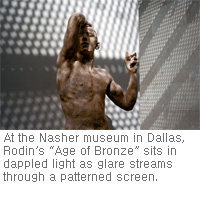
Dallas Museum Simmers in a Neighbor’s Glare
DALLAS — Two things were supposed to happen when the Nasher Sculpture Center opened here in 2003. Famous works like Rodin’s “Age of Bronze” and Matisse’s “Madeleine I” were to be bathed in copious sunlight streaming through a glass roof. And new vigor was to come to the surrounding neighborhood.
The results exceeded expectations. And Dallas has a mess on its hands.
The center, designed by Renzo Piano and Peter Walker, was considered so appealing that a 42-story condominium called Museum Tower sprouted across the street. But the glass skin of the condo tower, still under construction, now reflects so much light that it is threatening artworks in the galleries, burning the plants in the center’s garden and blinding visitors with its glare.
No one quite knows what to do. The condo developer and museum officials are at loggerheads. Fingers are being pointed. Mr. Piano is furious. The developer’s architect is aggrieved. The mayor is involved. A former official in the George W. Bush administration has been asked to mediate.
The situation has been characterized by some here as a David-and-Goliath battle between a beloved nonprofit and commercial interests. But the dispute has also raised the broader question of what can happen when, as is currently the rage, cultural institutions are cast as engines of economic development.
The Nasher was seen as an important spur to the renaissance of downtown Dallas, much the way Lincoln Center was viewed as something of a cure for urban blight on the West Side of Manhattan. But the forces unleashed in these situations can prompt a distinctly uneasy relationship between cultural organizations and the neighborhood changes they attract.
“These things start to bump into each other,” said the mayor of Dallas, Mike Rawlings. “How we as a civic society power through this is an important moment for us. You’ve got a high-growth engine that is trying to do right by Giacometti.”
Dallas’s interest in raising its cultural profile is palpable here: the city has been building its arts district over the last 20 years; Saturday Cowboys Stadium hosted a simulcast of Mozart’s “Magic Flute” by the Dallas Opera. The Nasher problem has the whole city concerned and watching.
“Typically, neighborhood disputes are not this dramatic — an offending sign or a barking dog,” said Veletta Forsythe Lill, the executive director of the Dallas Arts District. “This is a cultural, civic and commercial tragedy. The Nasher is a kind of a masterpiece, and the building and the garden were perfectly designed.”
Mr. Piano said he designed the Nasher with natural light in mind. The museum has an arched glass roof with a perforated aluminum screen in an egg-crate pattern that directs the sun into the galleries, which were laid out in anticipation of the sun’s daily arc from southeast to southwest.
Now, sun, magnified by reflection, shines into the galleries from the north and raises the temperature in the sculpture garden — designed by Mr. Walker — to levels that jeopardize the specially planted live oak trees and grass.
“By doing this, they destroy completely the logic of the building,” Mr. Piano said in an interview.
For the museumgoer, the sculptures in the galleries and the garden can be obscured or distorted by distracting light patterns or glare. The museum was forced to install light-blocking panels inside the roof for a recent exhibition of works by Elliott Hundley because the reflections from the tower exceeded the acceptable light levels for the art.
Scott Johnson, the Los Angeles architect who designed Museum Tower, said he was willing to consider remedies but that the Nasher also had to be open-minded. “My responsibility is to fully vet solutions vis-à-vis Museum Tower — that’s my building,” he said. “But I can’t say sitting here now that the Nasher may not need to do something on their end.”
Museum Tower’s owners said in a statement, “All parties desire resolution to these issues as quickly as possible.”
